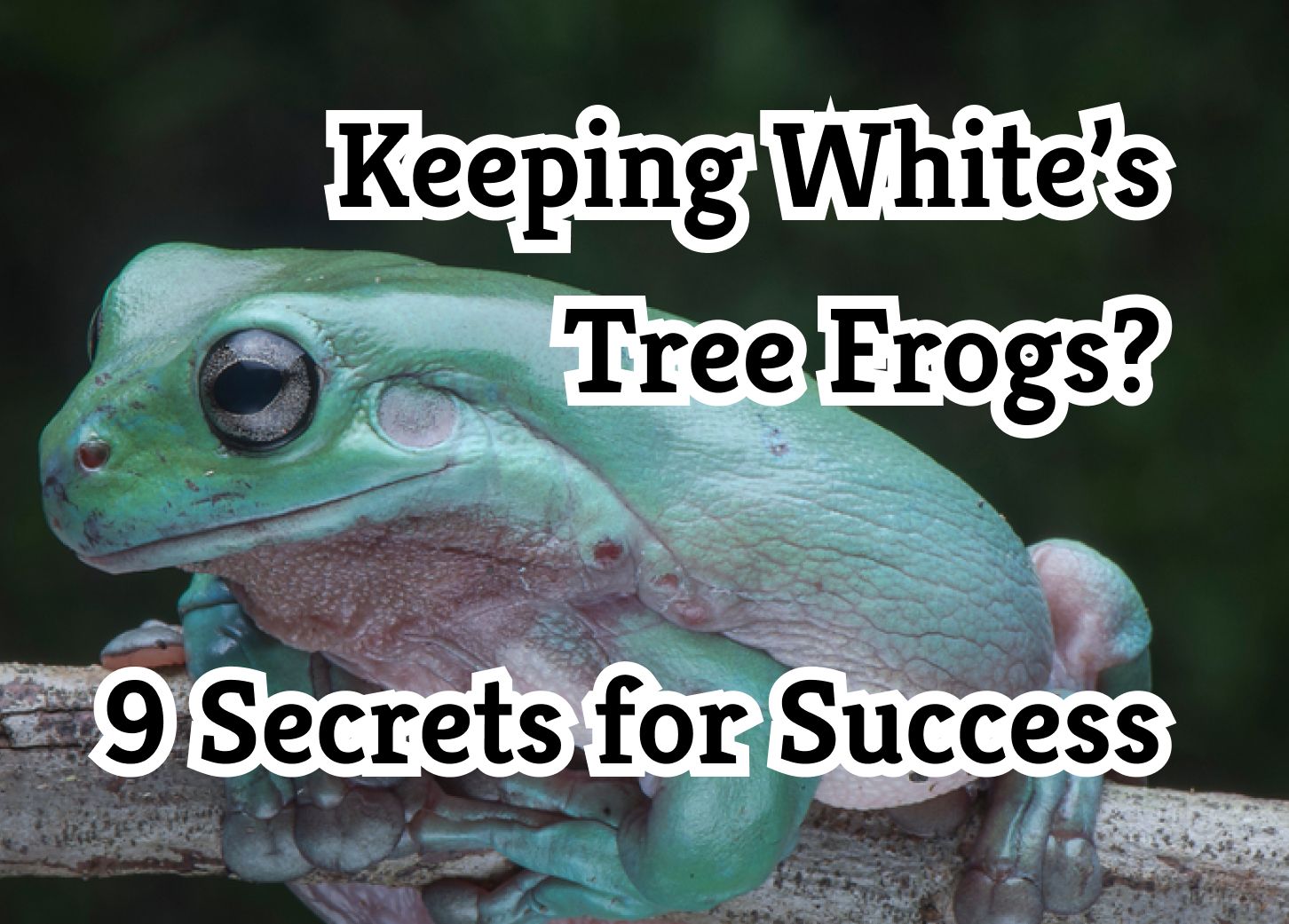9 Essential Tips for Successfully Keeping White's Tree Frogs

White’s tree frogs, also known as dumpy tree frogs due to their “dumpy” appearance, are one of the most popular amphibians kept as pets, and for good reason. These frogs are native to Australia, New Guinea, and Indonesia, and they have also been introduced in New Zealand. Because of the wide range of temperatures they endure in the wild, they have a hardy nature that makes them easy to care for compared to other tree frogs and a good pet for beginner frog owners.
White’s tree frogs typically grow to be 3-5 inches long, with the females being slightly larger in size than the males. The skin of this species can exhibit a range of blue and green colors, sometimes looking almost gray. Like other tree frogs, they can change color to some degree depending on different environmental factors, such as light intensity, temperature, and humidity levels. These frogs can live up to 16 years, with one reported to have lived 21 years!
Have you been thinking about adding a White’s tree frog (or several) to your family? Keep reading to find out 9 secrets for success in caring for White’s tree frogs.
1. Most of the costs associated with White’s tree frogs involve setting up their enclosure.
White’s tree frogs themselves can be quite affordable, with prices as low as $30 for one frog from a commercial pet store. If the frogs are obtained through breeders, however, the price can vary from $50-$150 depending on the frog’s skin and eye colors. These frogs can live mainly on crickets, which typically cost less than $10 per month for each fully grown frog.
Like many small amphibians and reptiles, many of the costs associated with keeping White’s tree frogs involves the initial set-up of their living area. The up-front cost of a tank, lighting, heat sources, thermometer, humidity gauge, and substrate/bedding can run up to $250. Because these frogs like to climb, they require large, tall terrariums to keep them happy, which can be quite costly.
2. White’s tree frogs are a good tree frog for beginners.
White’s tree frogs are easy to care for compared to many other amphibian species. They tend to be quite tame and therefore easy to handle, especially during the daytime because of their nocturnal nature. They can also adapt to different habitats to an extent due to a waxy coating on their skin that allows them to tolerate drier conditions than many tree frogs. Their hardiness makes them a good choice for beginning frog owners who may have some difficulty creating an ideal home environment.
In addition, managing a White’s tree frog’s environment is quite simple. These frogs should be given new water each day, and once they are full-grown, they only need to be fed 2-3 times per week. Their tank should be spot cleaned each day to remove fecal material, dead insects, and any other waste. If daily spot cleaning is done consistently, you may be able to go 2 or 3 months without replacing their substrate and doing a deep clean of the tank.
3. White’s tree frogs must be handled with care.
Although White’s tree frogs themselves are tolerant to being handled, there are several precautions that must be taken before holding them. Like all amphibians, these frogs have very permeable skin, so any chemicals present on your hands can be easily absorbed in potentially toxic levels.
Before handling your White’s tree frog, you must wash your hands thoroughly, rinsing thoroughly to ensure that no soap, lotion, or oils are present on your skin before touching them. Ideally, hands should be washed with non-chlorinated water, such as bottled water or tank water, as chlorine can be toxic to frogs and other amphibians.
4. White’s tree frogs need appropriate climbing enrichment in their enclosures.
White’s tree frogs live in trees in the wild, so the set-up of their terrariums should reflect this. Their tanks should be tall, made of glass to prevent overheating, and fitted with a tight-fitting lid so that the frogs cannot climb out and escape. Tanks should have a volume of at least 20 gallons for a single adult frog, or at least 30 gallons for 2-3 adult frogs, to ensure that they have enough space. Juvenile tree frogs can be kept in smaller aquariums, which may make it easier for them to find their food, but they will need an upgrade once they are full-sized.
Since White’s tree frogs like to climb trees, plenty of branches and foliage should be provided for enrichment. Live plants that are free of fertilizer or pesticide residues work best, as long as they are strong enough to hold the weight of the frogs. Having a wide variety of wood, bark, and vines keeps these tree frogs happy by allowing them to climb the way that they would in the wild.
5. White’s tree frogs thrive in humid environments.
Although White’s tree frogs can tolerate a range of environments, they do best when kept in conditions of 60-70% humidity. This allows them to stay moist and hydrated. This level of humidity can be maintained by misting the enclosure each day with dechlorinated or bottled water. A dish with the same type of water should also be provided that is large enough for the tree frogs to sit in to keep hydrated, but not deep enough that they could drown. The humidity of the tank can be measured using a hygrometer, which can be purchased from most pet shops.
The way in which the White’s tree frog’s enclosure is arranged can also help to keep the environment moist. For substrate, large gravel covered with chemical-free soil and large pieces of bark can be used to cover the bottom of the tank, ensuring that no materials are small enough for these tree frogs to accidentally eat. Any areas not covered by bark or foliage can be covered with sphagnum moss, which retains moisture. This can make the tree frog’s environment similar to their natural moist and warm habitat.
6. White’s tree frogs require a specific temperature gradient similar to their natural habitat.
Because White’s tree frogs come from tropical areas, their enclosure should be heated to mimic their natural habitat. Ideally, a temperature gradient should be created to allow your tree frog to choose between warmer basking areas and cooler resting areas. This can be done by placing a heat pad on one side of the tank and using a handheld and/or tank-side sticker thermometer to confirm a temperature of 75-85 °F during the day, with a drop of 5-10 °F at night.
Although UVB light is not strictly required when housing White’s tree frogs, the use of compact lamps can be beneficial. If a heat pad does not adequately heat the tank, small basking bulbs can be used in the canopy above the mesh ceiling to slightly increase the temperature. Lights can also allow frog owners to create a regular light cycle (12-14 hours “daylight”) to emulate light cycles in the wild, and they might even make your tree frog develop brighter colors! Lastly, supplemental UVB lighting can ensure that these tree frogs synthesize enough vitamin D, which assists in the absorption of calcium to prevent malnutrition; at a minimum, the frogs should have access to indirect sunlight.
7. White’s tree frogs mainly live on insects.
Luckily, White’s tree frogs are easy to feed because they do great on live crickets, which are both cheap and easily accessible from your local pet store. In addition, other insects, such as moths, beetles, and cockroaches, as well as a variety of worms can be fed. Full-grown tree frogs can even eat pinkie mice! Insects should be gut loaded with nutritious foods to ensure that these nutrients are passed onto your frog upon ingestion, and they should also be dusted with a calcium-vitamin D3 supplement. Crickets should be dusted before every other feeding in adult tree frogs and before every feeding in juveniles.
Due to their hefty appetite, White’s tree frogs are prone to obesity, so it is very important to pay close attention to how much they are being fed, as well as their body condition. Their body condition can be evaluated by looking at the ridges above their eardrums—if the ridges are prominent or starting to droop, the frog is obese and its feedings should be reduced. Alternatively, if there are no noticeable ridges, the frog may be underweight and should be fed either greater amounts or more frequently. Larger frogs can be given a few large crickets every 2-3 days, while smaller frogs can be given small crickets every 2-3 days. Juveniles can be fed 1-3 crickets daily.
8. White’s tree frogs should only be housed with other White’s tree frogs of similar size.
Don’t let the adorable face of the White’s tree frog fool you—like many other wild species, these frogs may cannibalize their smaller counterparts! If you are planning to keep multiple tree frogs, they should be relatively close in size to prevent the larger ones from eating the smaller ones.
Additionally, White’s tree frogs should only be house with other members of the same species. This is because other amphibians and reptiles may have different environmental requirements, so it can be difficult to cater to all species’ ideal temperatures, humidity levels, and light cycles.
9. White’s tree frogs should be obtained from a reputable breeder or seller.
Although White’s tree frogs are widespread in the wild, it is best if they are bought from a reputable breeder or seller who can ensure that they were bred and raised in captivity. Wild animals can become very stressed when kept indoors, which can leave them at risk of easily becoming sick and reduce their quality of life.
Breeders or sellers can also verify that the White’s tree frogs they are supplying are free of infectious diseases such as parasites, bacterial infections, or fungal infections. Infectious diseases can spread throughout populations of these tree frogs if several are housed in the same room. One particularly serious disease is chytridiomycosis, which is caused by a fungus. This disease has killed many White’s tree frogs in the wild, is very difficult to treat, and is usually fatal. General signs of poor health to look out for when you buy a tree frog include cloudy eyes, patchy coloration on the frog’s back, small swellings throughout the skin, and a reddish belly.
There you have it—9 secrets for success in owning White’s tree frogs! These tree frogs can make wonderful pets as long as you have done your research on owning an amphibian and made the effort to provide them with their ideal environment.
References
CostHelper. “Pet frog cost: how much does a pet frog cost?” Available at: https://pets.costhelper.com/frog.html.
Edmonds D. Reptiles Magazine. “White’s treefrogs.” December 1, 2011. Available at: https://www.reptilesmagazine.com/whites-treefrogs/.
Josh’s Frogs. “White’s tree frogs.” Available at: https://www.joshsfrogs.com/animals-for-sale/tree-frogs/whites-tree-frogs.html .
McLeod L. The Spruce Pets. “White’s tree frog species profile.” Available at: https://www.thesprucepets.com/whites-tree-frog-1236816.
Northampton Reptile Centre. “Whites tree frog care sheet.” Available at: https://www.reptilecentre.com/info-whites-tree-frog-care-sheet .
PetSmart. “White tree frog.” Available at: https://www.petsmart.com/reptile/live-reptiles/snakes-turtles-and-more/white-tree-frog-4032873.html .
Smithsonian’s National Zoo & Conservation Biology Institute. “White’s tree frog.” Available at: https://nationalzoo.si.edu/animals/whites-tree-frog.
Zilla-Rules. “White’s tree frog.” Available at: https://www.zillarules.com/information/care-sheets/white-s-tree-frog .



